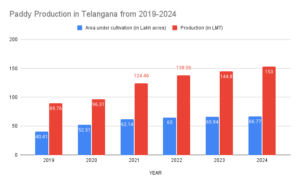Telangana has retained its position as the largest paddy-producing state for the second year. Here’s what led to high yield.
Published Nov 20, 2024 | 9:00 AM ⚊ Updated Nov 20, 2024 | 1:21 PM

Telangana had a record paddy production of 153 Lakh Metric Tonne this Kharif season
Telangana retained its position as the most paddy-producing state in India for the second year. The 153 Lakh Metric Tonne (LMT) of paddy produced during kharif and rabi this year is also a new record for the state.
Irrigation and Civil Supplies Minister N Uttam Kumar Reddy commended the achievement, calling it a rare and extraordinary feat in India’s agricultural landscape. The minister attributed the accomplishment to the state’s farmer-centric policies and the resilience of its agricultural community.
“This triumph is a testament to Telangana’s focused approach towards agricultural development and the strong collaboration between farmers and the government,” he said.
However, there is a long process that led to Telangana’s achievement this season. It’s a road that was paved by numerous factors, including policy, rainfall, supply and demand fluctuations, and agricultural research and development.
“About five years ago, there were only about 24 lakh acres of paddy in the newly formed Telangana. Before the bifurcation, erstwhile Andhra Pradesh was at the top in producing paddy in India,” Damodar Raju, principal scientist for rice at the Institute of Rice Research run by the Indian Council of Agricultural Research.
“Since then, the area for paddy cultivation has gone up yearly. In 2023, it was about 65.9 lakh acres, it went up to 66.7 lakh acres in 2024.
“Despite going up against Uttar Pradesh, which is much larger than Telangana, we can produce levels similar to that of undivided Andhra Pradesh,” he continued.
He credited the good paddy production of this kharif primarily to two factors: Increased yield and cultivation area, and ample irrigation. He noted that Telangana was competing with states like Punjab, Uttar Pradesh, and West Bengal.
“First and foremost, Telangana has received good rainfall during the past four years,” Raju explained. ”This ample rainfall meant that there was more water available for irrigation. Irrigation projects and tanks were filled up. Additionally, groundwater was replenished to a degree, and wells and borewells also became fuller,” he continued.
He noted that rice was also able to handle more water, unlike dry crops like cotton and maize.
“Paddy cultivation is a labour-intensive process around the transplantation stage. The old Samba Masoori seeds were often affected by pests and diseases, even taking longer and producing a low yield,” Raju recalled. He noted that the conditions drove up production costs for paddy.

Paddy Production in Telangana from 2019-2024
“We (ICAR) introduced better varieties to farmers here like the KNM 118, JJL 1738, Superfine RNR 8718,” Raju revealed. He added the Telangana Sona, a variety of fine rice became more popular than the other among the farmers.
“The new varieties had an improved yield and higher resistance to pests and diseases. This in turn brought down production costs, making paddy more attractive for farmers,” he observed.
He also explained that the ICAR was introducing dry and wet transplantation mechanisation into the process to tackle the labour-intensive nature of paddy farming.
“There are three primary factors in paddy cultivation: Labour, water, and seeds. We are slowly addressing the labour question, there is ample water, and the farmer started using more healthy varieties. This combination of factors made paddy profitable and easy, increasing the cultivation area,” he explained.
Additionally, he noted that communication played an important role in the growth of paddy production. “Whether through the Telangana Government Initiatives, ICAR’s Krishi Vigyana Kendras, or the media, the farmers were more educated about production practices,” he said.
“About three years ago, there was a dip in rice production because of global conflicts. Even the Indian government had to ban rice exports temporarily,” Raju said.
He noted that during this period there was a dip in rice production around Telangana due to monsoon fluctuations as well. He explained that the resulting increase in demand led to a spike in the minimum price which in turn caused more production in the state.
“Additionally, rice is an assured crop for farmers. With the prevailing conditions in Telangana, farmers opted to move to paddy instead of the dry crops like maize and cotton,” he noted.
He also stated that Telangana’s rice, fine rice specifically, has seen increased demand in states like Tamil Nadu, Karnataka, Maharashtra, and other Northern states.
He also noted that owing to the humongous fine rice production in the state, the government is mulling its use for the public distribution system and government hostels.
“Telangana is also a seed hub in India, every rabi season, the seed production companies sell a huge amount of seeds, making it complementary to paddy production,” he identified. He added that this also improved access to a variety of seeds for the farmers.
He also observed that there was an opportunity for the southern region to dominate the non-basmati export market. The basmati rice export market is dominated by the northern regions.
(Edited by Majnu Babu).

